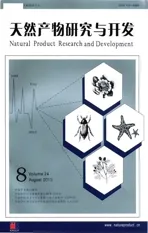番茄中皂苷类成分研究进展
2012-11-23陈思呈李典鹏
陈思呈,李典鹏
1广西植物功能物质研究与利用重点实验室广西植物研究所,桂林541006;2广西师范大学生命科学学院,桂林541004
番茄中皂苷类成分研究进展
陈思呈1,2,李典鹏1*
1广西植物功能物质研究与利用重点实验室广西植物研究所,桂林541006;2广西师范大学生命科学学院,桂林541004
皂苷因其在人体中具有重要的生理及药理活性一直是人们研究的热点。番茄是我们日常生活中最常食用的蔬菜,其主要活性物质除了人们熟知的番茄红素外尚含有含量并不低的水溶性番茄皂苷,目前国内有关番茄皂苷的研究报导较少。本文主要对上世纪70年代以来国外研究人员在番茄皂苷研究方面所取得的进展进行综述。
番茄;皂苷;活性;研究进展
番茄(Lycopersicon esculentum MILL.)为茄科番茄属植物,是我们日常食用最多的一年生蔬菜之一,也是一种含有多种有益身体健康的营养成分的食物。番茄中主要的营养成分就是番茄红素(Lycopene),为胡萝卜素中的一种。番茄红素是一种脂溶性的不饱和碳氢化合物,在番茄中除了脂溶性化合物外尚存在有含量并不低的水溶性皂苷类化合物。
目前国外的研究人员从番茄中陆续分离得到的番茄皂苷类物质有:TFI、α-tomatine、tomatosideA-B、lycoperosideA-D和 F-H、esculeoside A-D、pregnane glycoside等以及它们的部分苷元和衍生物。从番茄中所分离到皂苷的绝大部分为甾体生物碱类皂苷。
番茄皂苷具有一般皂苷的性质,国外特别是日本的研究人员对其理化性质及生理和药理活性进行了深入的研究,证明番茄皂苷具有强的降血脂、降胆固醇、抗动脉硬化、抗氧化、抑制癌细胞增殖等生理活性。以下仅就近年来在番茄皂苷的理化性质及其生理功能等方面的研究进展作简要介绍。
1 番茄皂苷的提取与分离
番茄皂苷主要存在于番茄的果实中,种子、叶子、茎等部位也有相当的含量。皂苷类化合物为水溶性物质,分离提取的过程有很大的相似性。一般的方法是,新鲜番茄(或叶子、茎等),经洗净、粉碎、加水离心、取上清液浓缩后经一系列柱色谱或再经高效液相色谱法制备分离得到。以番茄皂甙A的提取分离为例:新鲜番茄经洗净打碎后加水离心,上清液浓缩过Diaion HP-20树脂并用水和甲醇依次洗脱。甲醇洗脱部分再过ODS柱,40%~100%甲醇梯度洗脱,70%部分得到番茄皂苷A[1,2]。
2 番茄皂苷及其理化性质
1973年,日本的研究人员Hiroji Sato等从番茄种子中分离出了一种苦味素,这种苦味素被命名为TFI,TFI是一种新的呋喃甾醇皂苷,也是首次报导这种喃甾醇皂苷类物质是使西红柿种子产生苦涩味道的物质[3]。
上世纪七十年代,日本学者从番茄地上部分及未成熟的果实中分离得到α-番茄碱(α-tomatine),又名番茄素或番茄甙[4]。α-番茄碱在其它茄科植物(Solanum)中也存在,如茄子、马铃薯等,为一种含有D-木糖、D-半乳糖及两分子葡萄糖的甾体生物碱皂苷。tomatidine,是tomatine的水解产物,也就是tomatine苷元[5,6]。
上世纪80年代,日本及前苏联的研究人员从西红柿中分离或经酶法转化得到一类糖苷tomatoside,分别命名为tomatosideA和B。tomatoside A为呋喃甾醇型糖苷,tomatoside B为螺旋甾烷醇糖苷,tomatoside B可由存在于番茄种子中的含量为0.3%的neotigogenin(tomatoside B的苷元,)经酶或化学转化而得到[7]。
1996年,日本的Shoji Yahara从番茄叶子和果实中分离出了一类新的螺旋甾烷型糖苷lycoperoside,分别命名为lycoperoside A-D[8]。2004年他又从番茄果实中分离得到另一类甾体生物碱糖苷,分别命名为lycoperosideF-H[9]。
2004年,日本学者Yukio Fujiwara等从番茄果实中提取分离出一类番茄糖苷esculeoside,分别命名为螺旋甾烷型糖苷esculeosideA和辣茄碱型糖苷esculeosideB,其中esculeosideA是番茄中主要的皂苷类成分,在樱桃小番茄中其含量为番茄红素的三倍。esculeosideA苷元有esculeogenin A和isoesculeogenin A两种异构体[2,10]。2006年Takara又从番茄果实中分离得到两个此类化合物,分别为esculeosideC和esculeosideD,均为甾体生物碱糖苷[11]。
2005年Yukio Fujiwara等从过熟的西红柿中分离得到一种新的孕烷糖苷pregnane glycoside。第一个孕烷糖苷为日本的学者从七叶一枝花(Paris polyphilla)中获得,之后又从西红柿中获得了孕烷糖苷[12]。
从番茄中分离得到的皂苷类化合物及部分苷元理化性质如表1所示:

表1 番茄皂苷及部分苷元的理化性质Table 1 Physicochemical properties of tomato saponins and partial aglycons

图1 番茄中皂苷类化合物及部分苷元的结构Fig.1 The structures of saponins and partial aglycons in tomato
3 番茄皂苷类化合物的转化及生源关系
研究发现,从西红柿未成熟期到成熟期直至过熟期,皂苷成分的含量有显著的变化。在未成熟西红柿中主要存在α-tomatine,成熟期的番茄含有大量的esculeoside A等,过熟的西红柿中则主要存在着pregnane glycoside等化合物[4]。随着西红柿的成熟一个显著的变化是,番茄中α-tomatine含量的减少及esculeosideA含量的增加,α-tomatine与 escule-osideA可能的转化关系如图2所示[13]。与此同时,esculeosideB的含量也在增加,藤原等猜测esculeosideA可能为esculeosideB的前体物质,两者可能的化学关系如图3所示[2,13]。
实验证明乙烯的含量及吸收,在西红柿果实esculeosideA的积累中,起着重要的作用[14]。C22 αN→C22 βN的异构化作用是这种转化的最重要一步[15-16]。esculeosideA经酸水解后可转变成其苷元esculeogenin A。具有22S构型的esculeogenin A的异构体isoesculeogenin A在吡啶和水中回流反应,可以转变成esculeogenin B。esculeoside B的苷元esculeogenin B不仅可以从由esculeoside B经酶水解而得,还可以由isoesculeogenin A在吡啶和水中回流反应,转化为 esculeogenin B[10,17]。esculeogenin A在吡啶和水中回流反应,转化成一种孕烷衍生物,机理是吡啶从20位碳脱氢,使C-20和C-22之间形成双键及E环开环,最后形成一种孕烷衍生物[10-11]。isoesculeogenin A可以由esculeogenin A异构化而来,也可以由lycoperosideF经酸水解而得(isoesculeogenin A即lycoperosideF的苷元)[10,17]。此外,esculeogenin A在吡啶和水中反应可转化为pregnane (孕烷),再经生物合成为番茄孕烷糖苷pregnane glycoside,如图4所示[4,18]。pregnane在体内可以转变为雄甾酮(Androsterone)等甾体激素类化合物[4]。
tomatidine,是tomatine的水解产物,也就是tomatine的苷元。研究人员已经建立另一种有效的把tomatidine转化为一种孕烷衍生物的方法,转化率可以达到27.3%[19]。tomatidine室温下与吡啶和乙酸酐反应,发生乙酰化作用最终可以转变为孕烷衍生物,并且证明这种孕烷衍生物具有神经及NGF因子增强活性[20]。
4 番茄皂苷的生理及药理活性
4.1 番茄皂苷的抗癌和抗肿瘤活性
甾体生物碱糖苷一般都具有抗增殖活性和抑制肿瘤细胞系活性[21],但甾体皂苷并不是直接杀死癌细胞,而是通过与癌细胞增殖激素的拮抗作用达到抑制癌细胞的功效。实验表明:esculeoside A和αtomatine都具有细胞毒作用。通过皮肤外用 esculeogenin A还有抑制疱疹和皮肤癌活性[21]。考虑到各种甾体生物碱糖苷都有抗各种肿瘤细胞系的细胞毒活性这一事实,由于esculeosideB和esculeosideD等可以由esculeosideA转化而来,可以预计,它们和esculeosideA一样,也都具有极强的抗癌活性[2]。它们通过内生的外源凝集素进入细胞,这些外源凝集素为识别皂苷中糖基的特异受体[4]。此外,研究发现α-tomatine具有抗人乳腺癌细胞活性,能有效地抑制 (胸腺、结肠、肝脏和胃)癌细胞的生长[22,23]。研究人员给虹鳟鱼喂食2000 ppm的α-tomatine后发现,其肝脏及胃的肿瘤发生率降低了41.3%,并且在鱼体内组织中没有发现任何不良的病理学反应[5]。
4.2 番茄皂苷降血脂、降固醇及抗动脉硬化活性
研究发现esculeoside A及其苷元 esculeogenin A体外可抑制泡沫细胞的形成,为一种较好的酰基辅酶 A胆固醇酰基转移酶(acyl-coA:cholesterol acyltransferase,ACAT)抑制剂,是有前景的抗动脉粥样硬化症化合物[19]。
Fujiwara等给ApoE基因缺陷小鼠口服esculeoside A后,可以显著降低血清胆固醇、甘油三酸脂、低密度脂蛋白-胆固醇的水平,以及动脉粥样硬化病变区的面积,并观察不到任何的副作用。此项研究首次给出了证据,证明纯化的esculeogenin A可以显著的抑制ACAT蛋白的活性和降低动脉粥样硬化的发生[24]。它可以降低血清中低密度脂蛋白胆固醇的水平[25]
4.3 番茄皂苷的抗菌及抗病毒活性

图2 番茄成熟过程中α-tomatine转化成esculeoside A的假设途径Fig.2 Hypothetical conversion of α-tomatine to esculeoside A during tomato ripening
研究表明番茄碱糖苷(α-tomatine)能抑制细菌、病毒、真菌等微生物的生长,番茄碱糖苷在幼叶和绿色果实中含量较高,随着果实的成熟,番茄果中的番茄碱糖苷逐渐被降解,这也是为什么番茄成熟后易受到微生物的侵染而腐烂变质的原因,即与番茄成熟后的番茄碱糖苷含量降低,对微生物的抑制作用减弱的原因有关[5]。此外,番茄碱糖能激发免疫系统,可降低毛细血管的渗透性和抑制尿分泌的作用[26-27]。tomatoside A在番茄中的含量约为α-tomatine的四倍,但这并不意味着tomatoside A在杀菌活性及抗病毒能力方面比α-tomatine重要,这是由于这两种化合物存在于番茄的不同组织中[28]。这些生物碱糖苷的抗菌及降低胆固醇的能力被认为与其分子因具有的两性特征而产生的能降低水的表面张力及形成微胶团的能力有关。因此人们认为,不仅是红色番茄,食用绿色番茄也会对人体有益处,αtomatine具有广阔的开发前景[29,30]。
4.4 番茄皂苷对乙酰胆碱酯酶活性的影响
低浓度的番茄碱糖苷(1 mmol/L)对乙酰胆碱酯酶(生物神经传导中一种关键性的酶)有明显的激活作用,而高浓度(10 mmol/L)的番茄碱糖苷对乙酰胆碱酯酶有明显的抑制作用[31]。


5 问题与展望
当前,国内的研究人员对人参、苦瓜、薯蓣等植物中皂苷类物质的研究已经相当广泛和深入,但对于番茄皂苷类的研究只是处于开始阶段。在国际上,日本的研究人员在番茄皂苷的研究方面开展了不少工作,从上世纪70年代开始就已经陆续分离得到了多种番茄皂苷类化合物,除了对其理化性质有充分的研究外,部分皂苷的生理和药理活性也得到阐明,取得了不少进展。和其他皂苷类化合物对人体所具有的生理功能一样,番茄皂苷类化合物的活性也有待进一步广泛和深入的研究。
近年来,科学家们对番茄红素健康作用的研究有了很多新的突破,已经证明的包括:具有独特的抗氧化能力,可以清除人体内导致衰老和疾病的自由基;预防心血管疾病的发生;阻止前列腺的癌变进程,并有效地减少胰腺癌、直肠癌、喉癌、口腔癌、乳腺癌等癌症的发病危险。目前国内还很少报道有对番茄皂苷方面的研究。番茄皂苷为番茄中水溶性成分,而番茄红素为番茄中脂溶性成分,在加工生产番茄红素过程中,往往需要脱水而将番茄皂苷白白损失浪费掉。番茄皂甙具有多种生理和药理活性,尤其是在降血脂及抗动脉粥样硬化及方面具有独特的作用。因此,进一步开展番茄皂苷的提取分离及生理药理活性方面研究可拓展其用途,造福人类健康。
1 Jin T(金婷).Research progress on medicinal function and extraction and separation of saponins.Food Eng(食品工程),2008(1):19-21.
2 Yukio F,et al.Tomato steroidal alkaloid glycosides,esculeosides A and B,from ripe fruits.Tetrahedron Lett,2004:4915-4920.
3 Sato H,Sakamura S.A bitter principle of tomato seeds isolation and structure of a new furostanol saponin.Agric Bio Chem,1973,37:225-231.
4 Nohara T,et al.Physiological functions of solanaceous and tomato steroidal glycosides.Nat Med,2007(61):1-13.
5 Tao YX(陶永霞),et al.Study prospect and outlook on tomatine.Mod ern Food Sci Tech(现代食品科技),2002,2: 233-256.
6 Sayaka M,et al.Efficient conversion of tomatidine into neuritogenic pregnane derivative.Chem Pharm Bull,2007,55: 1077-1078.
7 AP Shchelochkova,et al.Tomatoside A from the seeds of lycopersicum esculentum.KhimiyaPrirodnykh Soedinenii,1980:386-391.
8 Yahara S,et al.Lycoperoside A-C,three stereoisomeric 23-acetoxyspirosolan-3β-ol β-lycotetraosides from Lycopersicon esculentum.Phytochemistry,1996,42:169-172.
9 Shoji Y,et al.Steroidal alkaloid glycosides from tomato(Lycopersicon esculentum).Nat Prod,2004(67):500-502.
10 Miho Y,et al.Tomato New Sapogenols,isoesculeogenin A and esculeogenin B.Chem Pharm Bull,2005,53:839-840.
11 Masateru O,et al.Steroidal alkaloid glycosides,esculeosides C and D,from the ripe fruit of cherry tomato.Chem Pharm Bull,2006,54:237-239.
12 Yukio F,et al.A new tomato pregnane glycoside from the overripe fruits.Chem Pharm Bull,2005,53:584-585.
13 Takao Yamanaka,Jean-Paul Vincken,Han Zuilhof,C22 isomerization in α-tomatine-to-esculeoside A conversion during tomato ripening is driven by C27hydroxylation of triterpenoidal skeleton.Agric Food Chem,2009:3786-3791.
14 Yoko I,et al.Involvement of ethylene in the accumulation of esculeoside A during fruit ripening of tomato(Solanum lycopersicum).Agric Food Chem,2009:3247-3252.
15 Kozukue N,et al.Dehydrotomatine and α-tomatine content in tomato fruits and vegetable plant tissues,Agric Food Chem,2004:2079-2083.
16 Iijima Y,et al.Metabolite annotations based on the integration of mass spectral information.Plant,2008:949-962.
17 Takao Y,et al.Isolation,characterization,and surfactant properties of the major triterpenoid glycosides from unripe tomato fruits.Agric Food Chem,2008,(56):11432-11440.
18 Sayaka M,et al.Distinction of absolute con?guration at C-22 of C-23-hydroxyspirostane and C-23-hydroxyspirosolane glycosides.Chem Pharm Bull,2007,55:1079-1081.
19 Yukio F,et al.esculeogenin A,a New tomato sapogenol,ameliorates hyperlipidemia and atherosclerosis in ApoE-deficient mice by inhibiting ACAT.Arterioscler Thromb Vasc Biol,2007,(27):2400-2406.
20 Duan JY(段江艳),Zhang XY(张晓燕).Study on the effect of tomatine on acetylcholinesterase activity.Acta Bot Boreal Occident Sin(西北植物学报),2008,28:501-505.
21 Tran Q,et al.New spirostanol steroids and steroidal saponins from roots and rhizomes of dracaera angustifolia and their antiproliferactive activity.Nat Prod,2001,(64):1127-1132.
22 Yukio,S,Tsuyoshi I.Cytotoxic major saponin from tomato fruits.Chem Pharm Bull,2003,51:234-235.
23 Mendel F,et al.Tomatine-containing green tomato extracts inhibit growth of human breast,colon,liver,and stomach cancer cells.Agric Food Chem,2009,(57):5727-5733.
24 Friedman M.Tomato glycoalkaloids:role in the plant and in the diet.Agric Food Chem,2002,(50):5751-5780.
25 Tao YX(陶永霞),Duan JH(段计华).Study of tomatine in tomato by high herformance liquid chromatography.Acad Peri Farm Prod Proc(农产品加工学刊),2007,(6):84-85.
26 Toshihiro N,et al.Physiological functions of solanaceous and tomato steroidal glycosides.Nat Med,2007,(61):1-13.
27 Heftmann E,Schwimmer S.Degradation of tomatine to 3β-hydroxy-5R-pregn-16-en-20-one by ripe tomatoes.Phytochem,1972,(11):2783-2787.
28 Bushway RJ,et al.High-performance liquid chromatographic determination of the tomato glycoalkaloid,tomatine,in green and red tomatoes.Agric Food Chem,1994,(42):2824-2829.
29 Kozukue N,et al.Dehydrotomatine and α-tomatine content in tomato fruits and vegetable plant tissues,Agric Food Chem,2004,(52):2079-2083.
30 Iijima Y,et al.Metabolite annotations based on the integration of mass spectral.Inform Plant,2008,(54):949-962.
31 Friedman M.Analysis of biologically active compounds in potatoes,tomatoes,and jimson weed seeds.Chromatography,2004,(1054):143-155.
Research Progress on the Saponins of Tomato
CHEN Si-cheng1,2,LI Dian-peng1*1Guangxi Key laboratory of Functional Phytochemicals Research and Utilization,Guangxi Institute of Botany,Guangxi Zhuang Autonomous Region and Chinese Academy of Sciences,Guilin 51006,China;2Guangxi Normal University,Guilin 541004,China
Saponins have been becoming the focus of research because of their activities on physiology and pharmacology in human body.Tomato is the most commonly eaten vegetable in our daily life.In addition to the well-known main active component:lycopene,tomato also contains high content water-soluble saponins..At present,there is few domestic research bout tomato saponins.This paper mainly reviews the international research progress from 1970s on tomato saponins.
Tomato;saponins;activity;research progress
1001-6880(2012)08-1141-06
2010-09-16 接受日期:2010-10-19
*通讯作者 Tel:86-773-3550103;Email:ldp@gxib.cn
R284.1;R285
A
